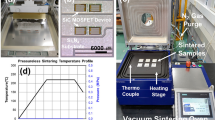Abstract
Highly reliable sintering technologies operating in extreme conditions are being extensively researched nowadays to improve the efficiency of power modules based on silicon carbide (SiC) devices for use in electric vehicles. In this study, the strength of silver (Ag) sintered joints used in SiC/direct bonded copper (DBC) was recorded at 21.9–23 MPa, at a pressure of 0.2 MPa and zero pressure, at 210°C using 83 wt.% and 88 wt.% Ag paste. Al2O3 and AlN DBCs with copper and Ag finishes were used. The inter-diffusion of the Cu-Ag and the Ag-Ag sintered interfaces contributed to increasing bonding strength. Based on the relationship between bonding layer thickness and densification in the pressurized and pressureless sintering conditions, if densification was at least 93%, the strength of the Ag joint strength was as high as 23.8 MPa. From the results of a simulation of thermal deformation based on the mismatch in the coefficients of thermal expansion of materials without considering heat transfer, the Al2O3 DBC material (rather than AlN) exhibited a small and dispersed deformation of the SiC/DBC sintered module. We also observed that Al2O3 DBC was favorable in terms of warpage.
Similar content being viewed by others
References
S. Ryu, B. Hull, S. Dhar, L. Cheng, Q. Zhang, J. Richmond, M. Das, A. Agarwal, J. Palmour, A. Lelis, B. Geil, and C. Scozzie, Mater. Sci. Forum 645, 969 (2010).
J. Millan, in Semiconductor Conference (CAS) (2012), p. 57.
H. Zhang, W. Li, Y. Gao, H. Zang, J. Jiu, and K. Suganuma, J. Electron. Mater. 46, 5201 (2017).
H. Chin, K. Cheong, and A. Ismail, Metall. Mater. Trans. B 41, 824 (2010).
K.N. Tu and K. Zeng, Mater. Sci. Eng. R Rep. 34, 1 (2001).
M. Abtew and G. Selvaduray, Mater. Sci. Eng. R Rep. 27, 95 (2000).
S.W. Yoon, M.D. Glover, and K. Shiozaki, IEEE Trans. Power Electron. 28(5), 2448 (2013).
http://acCuratus.com, http://www.matweb.com. Accessed 30 March 2018.
Maruwa Company, http://www.maruwa-g.com/e/pro ducts/ceramic/ceramic-substrate-4.html. Accessed 6 Apr 2018.
S.-K. Lin, S. Nagao, E. Yoko, C. Oh, H. Zhang, Y. Liu, S. Lin, and K. Suganuma, Sci. Rep. 6, 34769 (2016).
C. Oh, S. Nagao, T. Kunimune, and K. Suganuma, Appl. Phys. Lett. 104, 161603 (2014).
C. Oh, S. Nagao, and K. Suganuma, J. Mater. Sci. Mater. Electron. 26, 2525 (2015).
A. Michaelides, M.L. Bocquet, P. Sautet, A. Alavi, and D.A. King, Chem. Phys. Lett. 367, 344 (2003).
J. Yan, G. Zou, A.P. Wu, J. Ren, J. Yan, A. Hu, and Y. Zhou, Scr. Mater. 66, 582 (2012).
J.S. Horschhorn, Introduction to Powder Metallurgy (USA: The Colonial Press Inc., 1969), pp. 155–273.
A. Lis, K. Asama, T. Matsuda, T. Santo, and A. Hirose, J. Electron. Mater. 46, 6488 (2017).
W.S. Hong and S.S. Cha, J. Microelectron. Packag. Soc. 19, 67 (2012).
S. Divinski, M. Lohmann, and C. Herzig, Acta Mater. 49, 249 (2001).
R. Shioda, Y. Kariya, N. Mizumura, and K. Sasaki, J. Electron. Mater. 46, 1155 (2017).
E. Ide, S. Angata, A. Hirose, and K.F. Kobayashi, Acta Mater. 53, 2385 (2005).
K.S. Siow, J. Electron. Mater. 43, 947 (2014).
S. Wang, H. Ji, M. Li, and C. Wang, Mater. Lett. 85, 61 (2012).
Acknowledgments
This research was supported by the Korea Evaluation Institute of Industrial Technology (KEIT) and the Ministry of Trade, Industry & Energy (MOTIE) of the Republic of Korea (No. 10063263). We thank Sang-gyu Park and Yong-won Cho of ANSYS Korea for help with the simulation data for deformation (warpage analysis of Ag sintered SiC/DBC module).
Author information
Authors and Affiliations
Corresponding author
Rights and permissions
About this article
Cite this article
Hong, W.S., Kim, M.S., Kim, D. et al. Silver Sintered Joint Property Between Silicon Carbide Device and Ceramic Substrate for Electric Vehicle Power Module. J. Electron. Mater. 48, 122–134 (2019). https://doi.org/10.1007/s11664-018-6769-5
Received:
Accepted:
Published:
Issue Date:
DOI: https://doi.org/10.1007/s11664-018-6769-5




